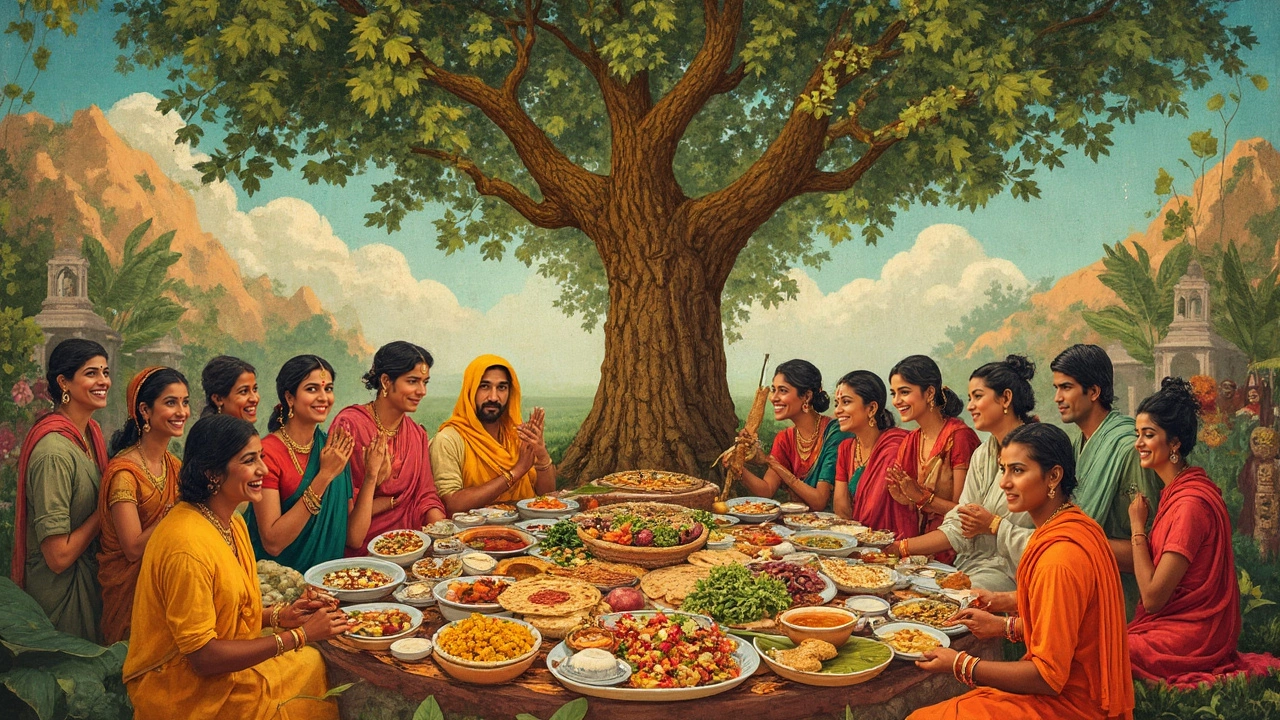Walk into any Indian home, and you’ll likely see vegetables front and center in the kitchen. That’s not just a coincidence—India is home to more vegetarians than the rest of the world put together. Eating meat-free is almost standard in many regions, and the reasons run centuries deep.
It might sound wild, but some regions in India have entire towns where finding chicken or lamb is harder than finding a WiFi signal in the mountains. This isn’t just about personal health. For most people, it goes way beyond fashion or western wellness trends. It’s about beliefs, family habits, and what’s cooked up daily in millions of homes.
If you’re wondering if it’s easy to stick to veggies in India, you’d be surprised how simple and tasty it is. Indian markets burst with local greens, root veggies, and fresh herbs, and even city folks often grow tomatoes, coriander, or chilies in their windows. Got a bit of space? You can join the crowd and start a tiny Indian-style veggie garden—all it takes is a couple of pots and some seeds from the local market.
- Vegetarian Roots: It’s Old and Deep-Rooted
- Religious Traditions Keep Veg Eating Strong
- Why Home Gardens Matter in Indian Homes
- Making Meat-Free Cooking Tasty and Practical
- Growing Your Own: Steps to a Simple Indian Veggie Patch
Vegetarian Roots: It’s Old and Deep-Rooted
Vegetarianism in India isn’t something new. It’s got some of the oldest roots in the world, with evidence going back thousands of years. The Indus Valley Civilization, which thrived around 2500 BCE, already showed signs of plant-focused diets. Later, as Hinduism, Jainism, and Buddhism took hold, sticking to veggies became a way of life for millions. All three of these religions preach some version of non-violence, or “ahimsa,” which means not harming living creatures. That belief actually guided entire communities to avoid eating meat, eggs, and even certain roots like onion and garlic in some sects.
Here’s a wild stat: according to a 2022 government survey, about 30% of Indians are vegetarian. The number jumps even higher in states like Rajasthan and Gujarat, where up to 70% people skip meat. Surprised? Many Indian families have been home-growing veggies for generations. They grow not because it’s trendy, but because that’s how their grandparents did it—and it stuck.
Check out the numbers—it’s not just a vibe, it’s reality:
| State | % of Vegetarians (2022) |
|---|---|
| Rajasthan | 70% |
| Gujarat | 61% |
| Punjab | 48% |
| All India Average | 30% |
One big reason behind these numbers is the influence of local culture. In some families, the day starts with washing fresh spinach from the yard—not just grabbing frozen stuff from a store. This goes hand in hand with religious beliefs, but also old-school habits. Sure, modern food is everywhere these days, but in plenty of households, the recipes, shopping lists, and even gardens revolve around a India vegetarian tradition that’s lasted thousands of years.
Religious Traditions Keep Veg Eating Strong
If you dig around for reasons why so much of India vegetarian lifestyle sticks, religion tops the list. Hinduism—practiced by nearly 80% of Indians—encourages vegetarian eating. Cows are considered sacred, so beef is out, and lots of people avoid all meat, fish, and eggs. Jainism takes things even further: followers won’t eat root veggies because pulling them up kills the whole plant. That means no onions, garlic, or potatoes for strict Jains. Buddhism, which has shaped lots of Indian culture, also supports non-violence, which often means skipping meat.
Check out this quick look at how religion guides what many Indians eat:
| Religion | Common Dietary Choices | Population in India (approx.) |
|---|---|---|
| Hinduism | Mainly vegetarian, no beef | 966 million |
| Jainism | Strict vegetarian, avoids root vegetables | 4.5 million |
| Buddhism | Many vegetarian, some vegan | 8 million |
| Sikhism | Many vegetarian, eggs/meat okay for some | 23 million |
| Islam | No pork, but not specifically vegetarian | 200 million |
This isn’t just about holidays or special rituals. For many, these choices show up on the table every single day. Ask anyone growing up in a traditional Hindu or Jain home and they’ll tell you, vegetables, lentils, and dairy aren’t just food—they’re a way of life.
It also means the food scene has adapted in wild ways. Most restaurants in India are split—“veg” or “non-veg”—with vegetarian options always guaranteed. School canteens, religious festivals, and community kitchens often serve only meat-free meals, so going veggie doesn’t feel like a sacrifice.

Why Home Gardens Matter in Indian Homes
In India, having a patch of green isn’t just about pretty flowers—it’s about food on the table. A study from the Indian Council of Agricultural Research found that over 60% of urban homes with a backyard or terrace use that space to grow vegetables and herbs. Even in tiny apartments, you’ll spot basil, coriander, or chili plants on sunny windowsills.
This habit grew from pure practical need. Food prices fluctuate. Extreme weather can hit supplies. When you grow your own vegetables, you get fresh, clean produce—and you skip the worry about chemicals or sketchy sources. During the pandemic, seed sales for kitchen gardens in cities like Mumbai and Delhi shot up by nearly 40% in just a few months.
People also do it for taste and nutrition. Home-grown tomatoes feel and taste way better than store-bought ones. Plus, it’s easy to step outside, pick what you need, and toss it straight into the pot. Here’s what you’ll typically find in a small Indian garden:
- Coriander (for garnishing)
- Tulsi (holy basil, used in tea)
- Methi (fenugreek leaves)
- Chilies (can’t do without them!)
- Tomatoes and brinjal (eggplant)
You don’t need fancy gear to start up. Old paint buckets, cracked pots, or recycled water bottles work fine. Seeds are cheap—just dry some from a market tomato or chili and you’re set. Watering and sunlight do the rest.
No wonder growing veggies has become almost second nature in most Indian homes. It links right back to the country’s love for a India vegetarian diet, giving families reliable access to what they eat the most. The tradition isn’t going anywhere soon, especially with food safety and climate worries on the rise. Here’s a quick look at some popular homegrown veggies and their growing time:
| Vegetable | Average Growing Time (days) | Common Use |
|---|---|---|
| Spinach | 30-45 | Saag, chapati stuffing |
| Tomato | 60-85 | Curry, salad |
| Chili | 70-90 | Spices, pickles |
| Coriander | 25-35 | Garnish, chutney |
| Fenugreek (Methi) | 20-25 | Curries, paratha |
Even if you start small, you’ll get daily value from a home garden—and a real taste of everyday Indian life.
Making Meat-Free Cooking Tasty and Practical
You’d think skipping meat might mean bland food, but in Indian kitchens, you get the exact opposite. The secret? Spices, simple tricks, and some totally clever ways to make veggies the star of the meal. People use onions, garlic, ginger, and an epic mix of spices like turmeric, cumin, coriander powder, and chili to pack every bite with flavor. Even the most basic dal (lentil curry) comes alive with a quick tempering of oil, cumin, and fresh coriander tossed in at the end.
One big reason that Indian food is so flavorful is variety. Each region has its own classic no-meat dishes. In the north, people crowd around plates of chole (spiced chickpeas) and aloo paratha (stuffed flatbread with potatoes). Down south, there’s dosai (crispy pancakes) and sambar (spicy lentil stew), and in the west, you’ll find dhokla (steamed chickpea flour cake) or undhiyu (a mixed veg casserole cooked in winter).
It’s easy to make your own veggie meals more interesting by borrowing these ideas. Here’s what helps:
- Start by learning the basics: sauté onions, garlic, ginger, and one or two spices at the beginning of your dish. This is called a "tadka" or tempering.
- Mix up the vegetables you use. Try what’s actually in season. In India, people often go for local veggies like bottle gourd, okra, and eggplant.
- Make sauces rich by adding coconut, tomatoes, or yogurt—each gives a different vibe and texture.
- Never go light on fresh herbs like coriander and mint; they make simple food smell and taste restaurant-worthy.
- If you want protein, mix in lentils, chickpeas, or paneer (Indian cottage cheese). These bulk up meals and keep you full for hours.
But here’s the tip that everyone in India follows: cook big batches, then use leftovers for breakfast or lunch the next day. Curries and dals taste even better after a night in the fridge. So, it’s not just tasty—it’s practical and saves time, too.

Growing Your Own: Steps to a Simple Indian Veggie Patch
If you’re in India, starting a veggie patch is a lot less complicated than people think. Whether you’ve got a backyard or just a tiny balcony, you can grow a surprising amount of food for your daily meals. Here’s how most Indian families get their first greens, right at home.
India vegetarian habits are rooted partly in how easy it is to access fresh veggies, even in cities. Home gardening isn’t new—it’s a tradition passed down for generations. In fact, according to a recent survey by the Indian Council of Agricultural Research, more than 60% of urban households with access to some open space have tried growing at least one edible plant.
Ready to take the plunge? Here’s a quick list to get you started with plants that grow well in India’s typical conditions:
- Tulsi (Holy Basil): Needs little space and lots of sunlight.
- Tomato: Easy in pots, and you’ll have fruit in about 60-70 days.
- Coriander (Dhaniya): Grows quick, perfect for garnishing every meal.
- Chili (Mirchi): A small pot and some regular watering is all you need.
- Bitter Gourd (Karela): Climbs on windows or balconies, gives a healthy harvest.
- Spinach (Palak): Fastest turnaround—about 30 days from planting to eating.
For best results, keep it simple at first. Here’s a basic step-by-step guide:
- Pick a sunny spot—at least 5 hours of sunlight a day.
- Use clean soil mixed with organic compost. Cow dung compost is super effective and easily available everywhere.
- Choose seeds from a trusted nursery or a local market—they tend to have better germination rates than supermarket stuff.
- Water in the morning or evening, but don’t flood the pots. Indian summers can be harsh, so watch the soil for dryness.
- Add a handful of compost every 2 weeks. It keeps the plants happy and the harvests steady.
Check out some handy numbers for what to expect, even in a tight space:
| Veggie | Time to First Harvest | Recommended Pot Size (Liters) |
|---|---|---|
| Tomato | 60-70 days | 12-15 |
| Spinach | 30 days | 8-10 |
| Coriander | 21-30 days | 6-8 |
| Chili | 60-75 days | 8-12 |
One more tip: water less frequently in the rainy season and protect delicate seedlings from heavy downpours. You can repurpose old plastic bottles or even tin cans as pots—just make sure they have drainage holes.
With these steps, you’re looking at fresh, homegrown veggies with hardly any fuss. Before you know it, you’ll be plucking your own coriander and chili, just like families have been doing for decades across India.

